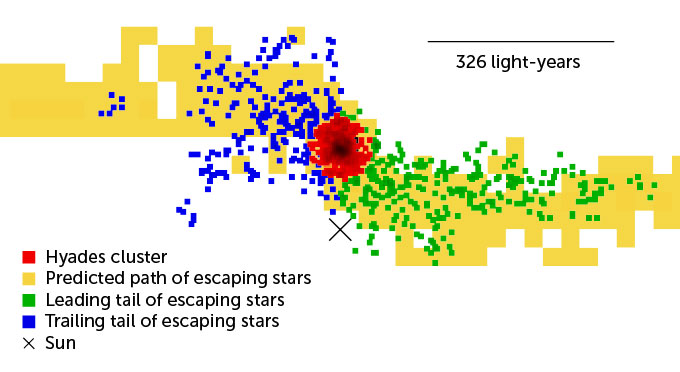







| BOOKS | F. A. Q. | ARTICLES | TALKS | ABOUT KEN | DONATE | BEYOND OUR KEN |
|---|
By Ken Croswell
Published on Science News (July 24, 2020)

The Hyades star cluster (in red) had long been predicted to be losing stars in two tails (yellow), but
astronomers first spotted the escaping stars only in 2018. Some of the escaping stars (green) lead and
other stars (blue) trail the cluster as it revolves around the Milky Way's center.
Credit: S. Roeser, E. Schilbach, and B. Goldman/Astronomy & Astrophysics 2019.
The closest cluster of stars to Earth is falling apart and will soon die, astronomers say.
Using the Gaia spacecraft to measure velocities of stars in the Hyades cluster and those escaping from it, researchers have predicted the cluster's demise. "We find that there's only something like 30 million years left for the cluster to lose its mass completely," says Semyeong Oh, an astronomer at the University of Cambridge.
"Compared to the Hyades' age, that's very short," she says. The star cluster, just 150 light-years away and visible to the naked eye in the constellation Taurus, formed about 680 million years ago from a large cloud of gas and dust in the Milky Way.
Stellar gatherings such as the Hyades, known as open star clusters, are born with hundreds or thousands of stars that are held close to one another by their mutual gravitational pull. But numerous forces try to tear the clusters apart: supernova explosions from the most massive stars eject material that had been binding the cluster together; large clouds of gas pass near the cluster and yank stars out of it; the stars themselves interact with one another and jettison the least massive ones; and the gravitational pull of the whole Milky Way Galaxy lures stars away too. As a result, open star clusters rarely reach their billionth birthday.
The Hyades has survived longer than many of its peers. But astronomers first saw signs of trouble there in 2018, when teams in Germany and Austria independently used the European Space Agency's Gaia space observatory to find numerous stars that had escaped the cluster. These departing stars form two long tails on opposite sides of the Hyades - the first ever seen near an open star cluster. Each stellar tail stretches hundreds of light-years and dwarfs the cluster itself, which is about 65 light-years across.
In the new work, posted July 6 at ArXiv.org, Oh and Cambridge colleague N. Wyn Evans analyzed how the cluster has lost stars over its life. It was born with about 1,200 solar masses but now has only 300 solar masses left. In fact, the two tails of escapees possess more stars than does the cluster. And the more stars the cluster loses, the less gravity it has to hold on to its remaining members, which leads to the escape of additional stars, exacerbating the cluster's predicament.
Siegfried Roeser, an astronomer at Heidelberg University in Germany who led one of the two teams that discovered the cluster's tails, agrees that the Hyades is in its sunset years. But he worries that it's too early to pin a precise date on the funeral. "That seems to be a little bit risky to say," Roeser says. Running a computer simulation with the stars' masses, positions, and velocities should better show what will happen in the future, he says.
The main culprit behind the cluster's coming demise, Oh says, is the Milky Way. Just as the Moon causes tides on Earth, lifting the seas on both the side facing the Moon and the side facing away, so the Galaxy exerts tides on the Hyades: the Milky Way pulls stars out of the side of the cluster that faces the Galactic center as well as the cluster's far side.
Even millions of years after the cluster disintegrates, its stars will continue to drift through space with similar positions and velocities, like parachutists jumping out of the same airplane. "It's still probably going to be detectable as a coherent structure in position-velocity space," Oh says, but the stars will be so spread out from one another that they will no longer constitute a star cluster.
Ken Croswell earned his Ph.D. in astronomy from Harvard University and is the author of The Alchemy of the Heavens and The Lives of Stars.
"An engaging account of the continuing discovery of our Galaxy...wonderful." --Owen Gingerich, The New York Times Book Review. See all reviews of The Alchemy of the Heavens here.
"A stellar picture of what we know or guess about those distant lights."--Kirkus. See all reviews of The Lives of Stars here.
| BOOKS | F. A. Q. | ARTICLES | TALKS | ABOUT KEN | DONATE | BEYOND OUR KEN |
|---|